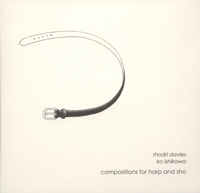| Compositions for Harp and Sho Rhodri Davies - Harp Ko Ishikawa - Sho |
There are differences and similarities, and some striking inversions of expectation in this duo. The instruments themselves, for example, are both constructions of parallel lines: the vertical tubes of the bamboo mouth organ – the sho – and the vertical lines of the harp strings. Sounds emerge from the sho largely without attack, as if seeping into the earth’s atmosphere from some far-away place, and though this is diametrically opposed to the customary brittle attack of the harp, Rhodri Davies’s use of E-Bows subverts the passive-aggressive romanticism of the harp, bringing its vibrating strings closer to the sho’s vibrating reeds. David Toop (read on below) Buy this album now CD: £12.00+ p&p |
| Please click here for other recordings by Rhodri Davies |
TRACKS
- Aka to Ao - Taku Sugimoto (18:04)
- Torso - Masahiko Okura (13:01)
- Three Drops of Rain / East Wind / Ocean - Antoine Beuger (20:58)
- Strings and Pipes of the Same Length Float on Waves - Toshiya Tsunoda (16:01)
note on "strings and pipes of the same length float on waves" - Toshiya Tsunoda
sho : harp
sine wave
sho pipe and harp string which have the same length are sounded in parallel with a pair of sine wave. recorded audio signal is passed through a gate device which cuts the audio signal under a certain established voltage. As a result, what we hear is an audio signal which ebbs and flows over the level set by the device.
Recorded by Masae Okura on 4th March, 2006 at
Tanker, Tokyo
Drawings by Masahiko Okura
Produced by Taku Unami
Thanks to Kahimi Karie, Fumiko Masaki, Otomo Yoshihide,
Yuko Uesu, Tomoko Mouri, Kazushige Kinoshita, Momo Nonaka
2006 Hibari Music
Harp and Sho - Rhodri Davies / Ko Ishikawa
There are differences and similarities, and some striking inversions of expectation in this duo. The instruments themselves, for example, are both constructions of parallel lines: the vertical tubes of the bamboo mouth organ – the sho – and the vertical lines of the harp strings. Sounds emerge from the sho largely without attack, as if seeping into the earth’s atmosphere from some far-away place, and though this is diametrically opposed to the customary brittle attack of the harp, Rhodri Davies’s use of E-Bows subverts the passive-aggressive romanticism of the harp, bringing its vibrating strings closer to the sho’s vibrating reeds.
Perhaps Davies places the instrument on its side, so vertical becomes horizontal to align with vertical. A series of thin cutting lines counterbalances a series of hollow tubes.
Auras of national identity have collected around these two instruments – the role of the sho in Japan’s ancient gagaku court music and the place of the harp in Welsh cultural history – but Ko Ishikawa and Rhodri Davies, though connected to these histories in subtle and complex ways, approach their collaboration almost as mathematicians rather than cultural envoys. Together they can sound like oracles to the court of some unknown country, engaged in soundings, forecasts and experimental transmissions, testing the density of air and the elasticity of time. But this is deceptive. In the best sense, they make plain music of few associations, modest yet resilient, music that seeks for a clean silence in which to exhale.
David Toop - quoted on www.rhodridavies.com
| Instruments: | Harp,Sho |
| Genre: | Contemporary / Experimental |
| Format: | CD |
| Our Ref: | A0281 |
| MCPS: | hibari-09 |
| Label: | Hibari Music |
| Year: | 2006 |
| Origin: | Japan |
